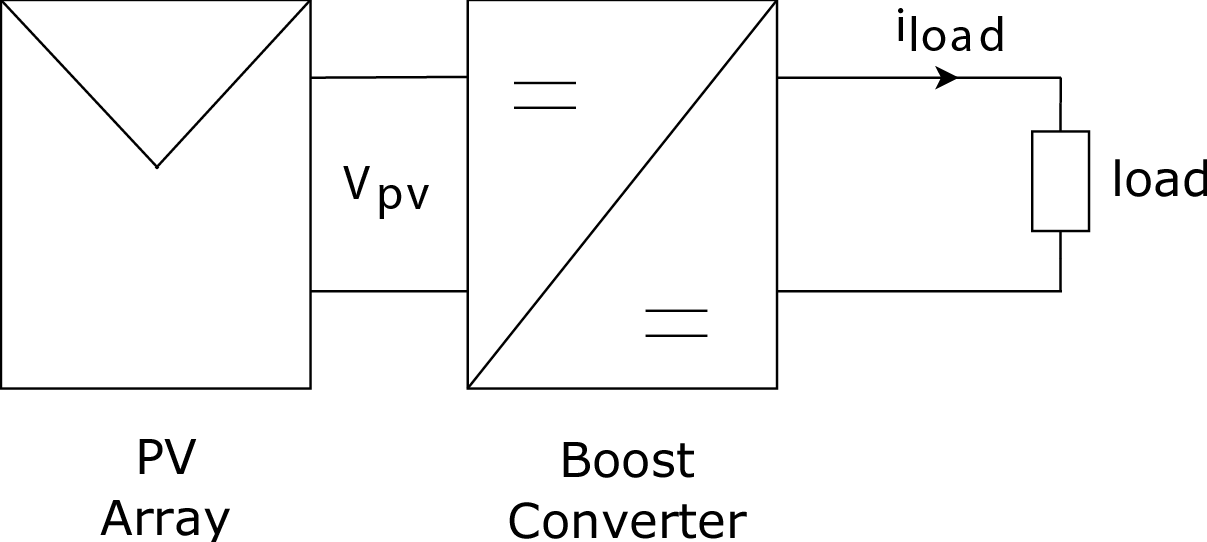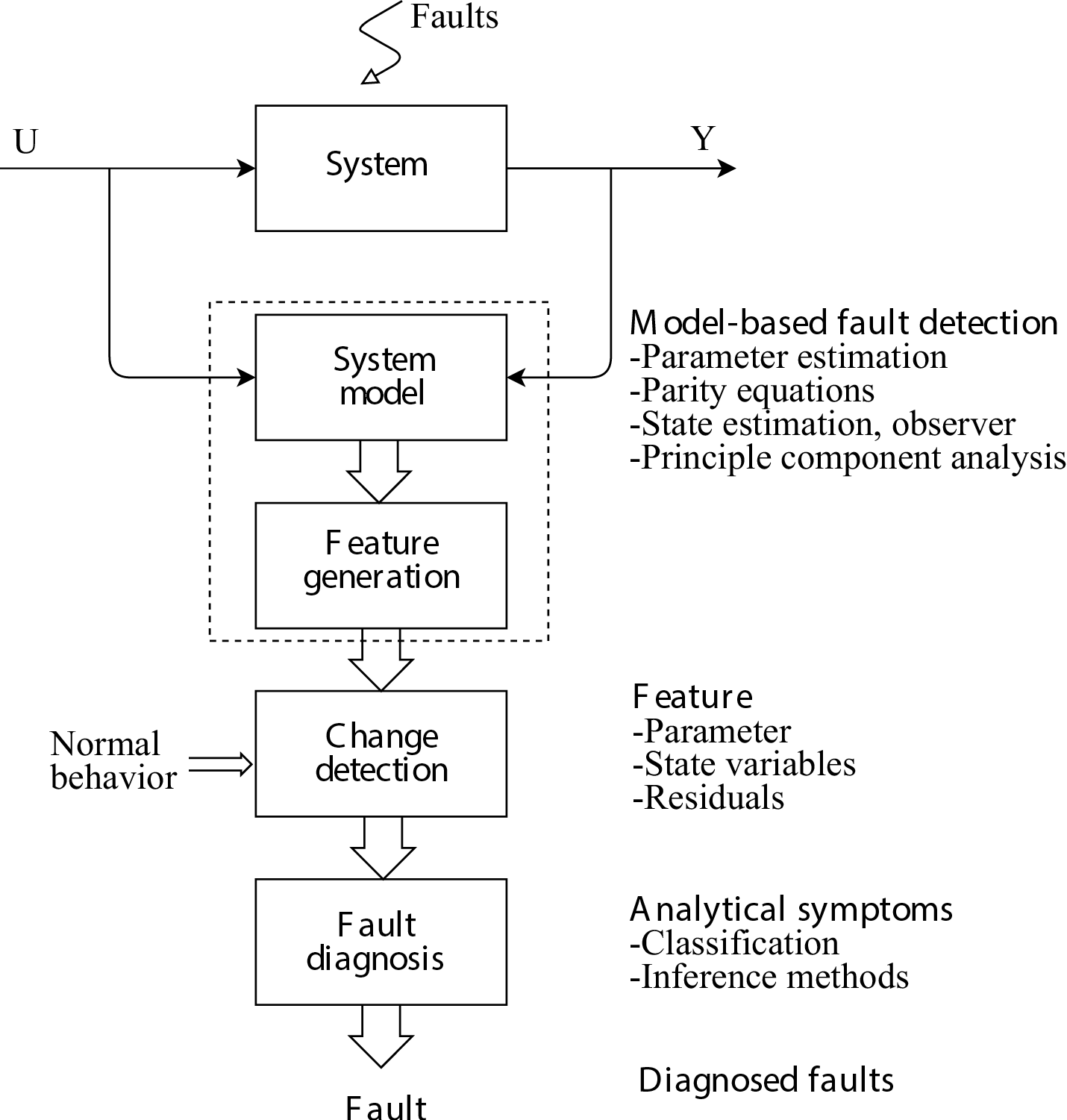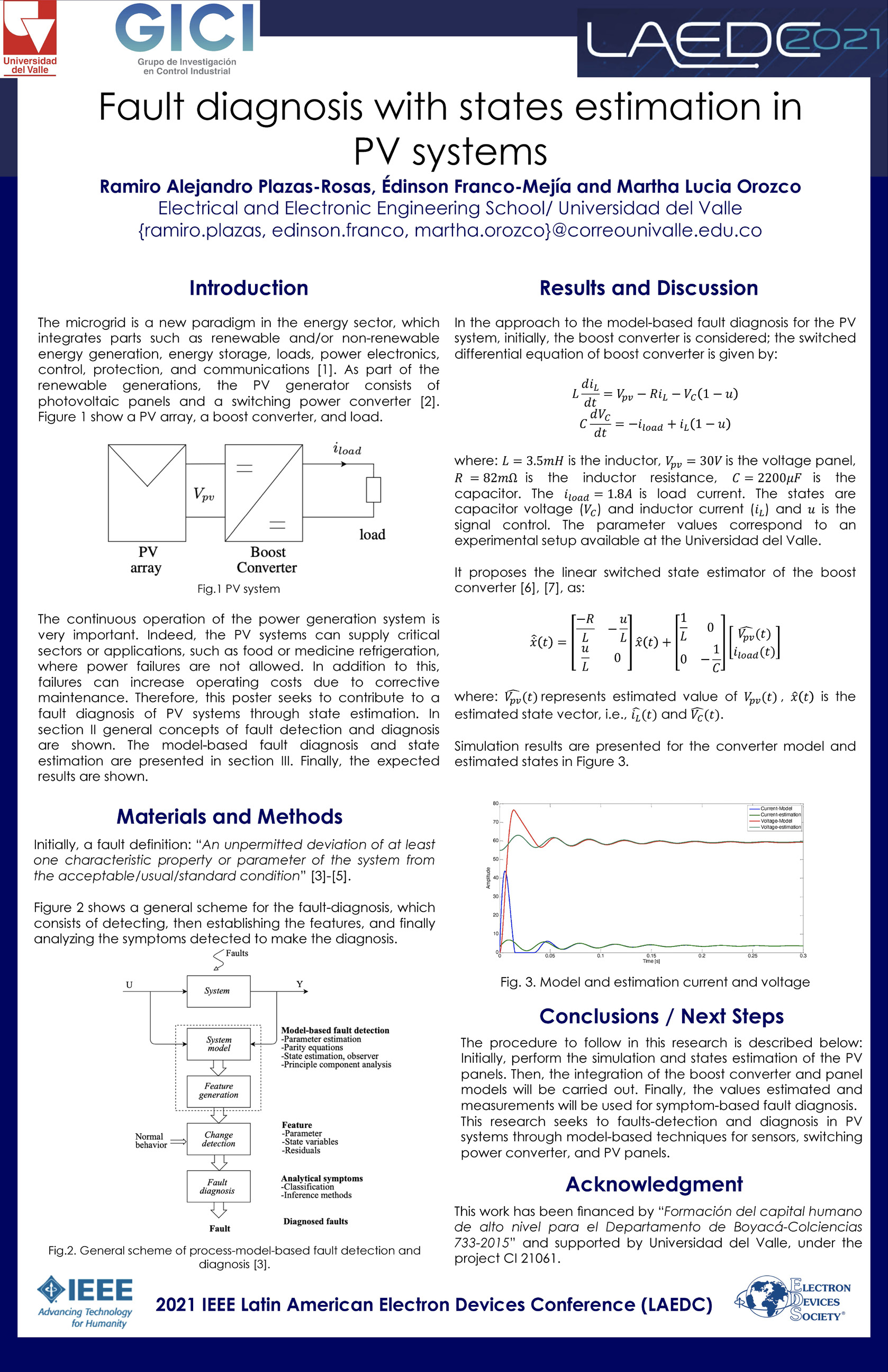Fault diagnosis with states estimation in PV systems
Diagnóstico de fallas con estimación de estados en sistemas fotovoltaicos
Ramiro Alejandro Plazas-Rosas1, Édinson Franco-Mejía2,
Martha Lucia Orozco-Gutiérrez3
Plazas-Rosas, R. A; Franco-Mejía, E;
Orozco-Gutiérrez, M. L. Fault diagnosis with states estimation in pv systems. Tecnología en Marcha. Vol. 34, especial. Noviembre LAEDC 2021. Pág 3-9. https://doi.org/10.18845/tm.v34i6.5965
https://doi.org/10.18845/tm.v34i6.5965
Keywords
Fault; power converter; photovoltaic; model-based; estimation; behavior.
Abstract
The photovoltaic systems are electrical, electronic, and mechanical elements. These systems also face different environmental and operating conditions susceptible to failure. In addition, photovoltaic systems can be the only source of electricity generation, and an affectation on the energy supply can harm the community. In many places, photovoltaic systems are the only source of energy because they are not part of what is known in Colombia as the National Interconnected System (SIN). Which comprises the direct connection between large generators (hydroelectric and/or thermal plants) and consumers. In fact, PV system damage would affect food refrigeration or everyday things like charging a cell phone. Therefore, it is necessary to register, monitor the operation elements of PV systems, and develop strategies that allow the diagnosis to detect faults. In this work, we propose a fault-diagnosis using the PV systems measurements that is, power converter, photovoltaic panels with also mathematical models to determine the deviation between the estimated and measured signals as voltages and currents.
Palabras clave
Falla; convertidor de potencia; fotovoltaico; basado en modelo; estimación; comportameinto.
Resumen
Los sistemas fotovoltaicos constan de elementos eléctricos, electrónicos y mecánicos. Estos sistemas, también se enfrentan diferentes condiciones ambientales y operativas susceptibles de fallar. Además, los sistemas fotovoltaicos pueden ser la única fuente de generación eléctrica, y una afectación en el suministro energético puede perjudicar a la comunidad. En muchas lugares, los sistemas fotovoltaicos son la única fuente de energía, ya que no forman parte de lo que se conoce en Colombia como el Sistema de Interconectado Nacional (SIN). Este consiste en la conexión directa entre grandes generadores (centrales hidroeléctricas y/o térmicas) y los consumidores. De hecho, un daño del sistema fotovoltaico puede afectar la refrigeración de alimentos o cosas cotidianas como cargar un teléfono celular. Por lo tanto, es necesario registrar, monitorear los elementos de operación de los sistemas fotovoltaicos y desarrollar estrategias que permitan el diagnóstico para detectar fallas. En este trabajo, proponemos un diagnóstico de fallas utilizando las medidas de los sistemas fotovoltaicos, es decir, convertidor de potencia, paneles fotovoltaicos y ademas con modelos matemáticos para determinar la desviación entre las señales estimadas y medidas como tensiones y corrientes.
Introduction
The microgrid is a new paradigm in the energy sector, which integrates parts such as renewable and/or non-renewable energy generation, energy storage, loads, power electronics, control, protection, and communications [1]. As part of the renewable generations, the PV generator consists of photovoltaic panels and a switching power converter [2]. Figure 1 show a PV array, a boost converter, and load.

Figure 1. PV system.
The continuous operation of the power generation system is very important. Indeed, the PV systems can supply critical sectors or applications, such as food or medicine refrigeration, where power failures are not allowed. In addition to this, failures can increase operating costs due to corrective maintenance. Therefore, this paper seeks to contribute to a fault diagnosis of PV systems through state estimation. In section II general concepts of fault detection and diagnosis are shown. The model-based fault diagnosis and state estimation are presented in section III. Finally, the expected results are shown.
Fault-detection and diagnostic
Initially, a fault definition: “An unpermitted deviation of at least one characteristic property or parameter of the system from the acceptable/usual/standard condition” [3]-[5].
Figure 2 shows a general scheme for the fault-diagnosis, which consists of detecting, then establishing the features, and finally analyzing the symptoms detected to make the diagnosis.

Figure 2. General scheme of process-model-based fault detection and diagnosis. Source [3].
Model-based fault diagnosis
In the approach to the model-based fault diagnosis for the PV system, initially, the boost converter is considered; the switched differential equation of boost converter is given by:
 (1)
(1)
where: L is the inductor,  is the voltage panel, R is the inductor resistance, C is the capacitor. The states are capacitor voltage (
is the voltage panel, R is the inductor resistance, C is the capacitor. The states are capacitor voltage ( ) and inductor current (
) and inductor current ( );
);  is the signal control.
is the signal control.
Table 1 shows the values used in the simulation, where  ,
,  and
and  are the equilibrium points. The parameter values correspond to an experimental setup available at the Universidad del Valle.
are the equilibrium points. The parameter values correspond to an experimental setup available at the Universidad del Valle.
Table 1. Parameters and equilibrium points.
|
Parameter |
Value |
|
R |
82mW |
|
L |
3.5mH |
|
C |
2200mF |
|
|
1.8A |
|
|
30V |
|
|
0.5 |
|
|
3.6A |
|
|
59.4V |
It proposes the linear switched state estimator of the boost converter [6],[7], as:

where:  represents estimated value of
represents estimated value of  .
.
 are the estimated states vector, i.e.,
are the estimated states vector, i.e.,  and
and  .
.
Simulation results are presented for the converter model and estimated states in figure 3. The green lines correspond to the estimation of current and voltage, where the estimation starts with the initial conditions as the equilibrium points. While the red and blue lines, voltage and current, respectively, correspond to the model response. It also showed a transient because the initial conditions of the model are zero. After the transitory period, it is observed that the state estimation errors decrease.

Figure 3. Model and estimation current and voltage.
Conclusions
The procedure to follow in this research is described below: Initially, perform the simulation and states estimation of the PV panels. Then, the integration of the boost converter and panel models will be carried out. Finally, the values estimated and measurements will be used for symptom-based fault diagnosis. This research seeks to faults-detection and diagnosis in PV systems through model-based techniques for sensors, switching power converter, and PV panels.
Acknowledgement
This work has been financed by “Formación del capital humano de alto nivel para el Departamento de Boyacá-Colciencias 733-2015” and supported by Universidad del Valle, under the project CI 21061.
References
[1] E. Franco-Mejia, R. A. Plazas-Rosas, A. Gil-Caicedo, R. Franco-Manrique and E. Gomez-Luna, ”Pilot nanogrid at Universidad del Valle, for research and training in control and management of electrical networks in non-interconnected areas,” 2017 IEEE 3rd Colombian Conference on Automatic Control (CCAC), Cartagena, 2017, pp. 1-6.
[2] A. Triki-Lahiani, A. Bennani-Ben Abdelghani, and I. Slama-Belkhodja, “Fault detection and monitoring systems for photovoltaic installations: A review,” Renewable and Sustainable Energy Reviews, vol. 82, no. March, pp. 2680–2692, Feb. 2018.
[3] R. Isermann, Fault-Diagnosis Applications. Berlin, Heidelberg: Springer Berlin Heidelberg, 2011.
[4] IFAC, “Terminology in the Area of Fault Management,” TC 6.4. Fault Detection, Supervision & Safety of Techn.Processes-SAFEPROCESS, 2018. [Online]. Available: https://tc.ifac-control.org/6/4/terminology/terminology-in-the-area-of-fault-management. [Accessed: 22-Feb-2020].
[5] S. X. Ding, Model-based Fault Diagnosis Techniques. Berlin, Heidelberg: Springer Berlin Heidelberg, 2008.
[6] J. Poon, P. Jain, I. C. Konstantakopoulos, C. Spanos, S. K. Panda, and S. R. Sanders, “Model-Based Fault Detection and Identification for Switching Power Converters,” IEEE Transactions on Power Electronics, vol. 32, no. 2, pp. 1419–1430, Feb. 2017.
[7] P. Jain, J.-X. Xu, S. K. Panda, J. Poon, C. Spanos, and S. R. Sanders, “Fault diagnosis via PV panel-integrated power electronics,” in 2016 IEEE 17th Workshop on Control and Modeling for Power Electronics (COMPEL), 2016, pp. 1–6.

Ilustration 1. Presented Poster at LAEDC 2021.
1 Electrical and Electronic Engineering School/Universidad del Valle. Colombia. Industrial Control Research Group. Ph.D. student.
Email: ramiro.plazas@correounivalle.edu.co  https://orcid.org/0000-0001-6595-3839
https://orcid.org/0000-0001-6595-3839
2 Electrical and Electronic Engineering School/Universidad del Valle. Colombia. Industrial Control Research Group. Professor.
Email: edinson.franco@correounivalle.edu.co  https://orcid.org/0000-0003-4045-3808
https://orcid.org/0000-0003-4045-3808
3 Electrical and Electronic Engineering School/Universidad del Valle. Colombia. Industrial Control Research Group. Professor.
Email: martha.orozco@correounivalle.edu.co https://orcid.org/0000-0002-5458-2427
https://orcid.org/0000-0002-5458-2427

